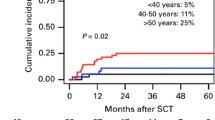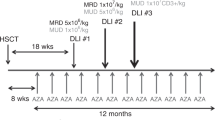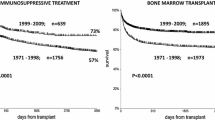Abstract
The major cause of treatment failure following allogeneic bone marrow transplantation for acute leukaemia is disease relapse. In an attempt to reduce post- transplant relapse in 33 children with high-risk acute leukaemia who received a related or unrelated bone marrow transplant, the pre-transplant conditioning regimen was intensified by the addition of idarubicin. Its toxicity and effects on survival were evaluated over a 57-month period. Toxicity, largely gastrointestinal, was increased but acceptable, and there was no specific regimen-related toxicity. Relapse rates were low (24%) in this high risk group, but mortality was increased in those receiving unrelated donor grafts, largely due to sepsis. Idarubicin does appear to have a role to play in the conditioning regimen of patients with high-risk acute leukaemia undergoing BMT, and may reduce relapse rates without increasing transplant-related mortality.
Similar content being viewed by others
Author information
Authors and Affiliations
Additional information
Part of this data was reported as an abstract and poster at British Society of Haematology, Glasgow, April 1998
Rights and permissions
About this article
Cite this article
Lawson, S., Williams, M. & Darbyshire, P. Use of idarubicin in pre-transplant conditioning in children with high-risk acute leukaemia. Bone Marrow Transplant 24, 953–958 (1999). https://doi.org/10.1038/sj.bmt.1702029
Received:
Accepted:
Published:
Issue Date:
DOI: https://doi.org/10.1038/sj.bmt.1702029
- Springer Nature Limited




